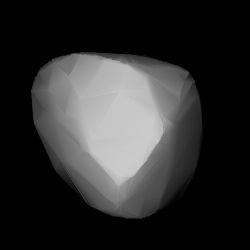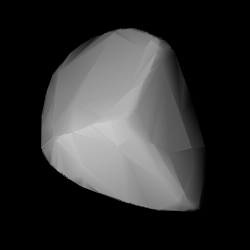Related Research Articles
Pawlowia, provisional designation 1923 OX, is a background asteroid from the central regions of the asteroid belt, approximately 20 kilometers in diameter. It was discovered on 5 October 1923, by Soviet astronomer Vladimir Albitsky at the Simeiz Observatory on the Crimean peninsula. The asteroid was named after Russian physiologist and Nobelist Ivan Pavlov.

1165 Imprinetta, provisional designation 1930 HM, is a carbonaceous Meliboean asteroid from the outer regions of the asteroid belt, approximately 49 kilometers (30 mi) in diameter. It was discovered on 24 April 1930 by Dutch astronomer Hendrik van Gent at the Union Observatory in Johannesburg, South Africa. The asteroid was named after Imprinetta Gent, wife of the discoverer.
2038 Bistro, provisional designation 1973 WF, is a stony asteroid from the inner regions of the asteroid belt, approximately 12 kilometers in diameter. The asteroid was discovered on 24 November 1973, by Swiss astronomer Paul Wild at the Zimmerwald Observatory near Bern, Switzerland. It was named for the Bistro restaurant.

1244 Deira is a dark background asteroid and slow rotator from the inner region of the asteroid belt. The X-type asteroid has an exceptionally long rotation period of 210.6 hours and measures approximately 31 kilometers in diameter. It was discovered on 25 May 1932, by English-born South African astronomer Cyril Jackson at the Union Observatory in Johannesburg, who named it after Deira, an old kingdom near his birthplace, the market town of Ossett, located in West Yorkshire, England.

1555 Dejan, provisional designation 1941 SA, is an asteroid from the background population of the central regions of the asteroid belt, approximately 22 kilometers in diameter. It was discovered on 15 September 1941, by Belgian astronomer Fernand Rigaux at the Royal Observatory of Belgium in Uccle. The asteroid was named after Dejan Đurković, son of Serbian astronomer Petar Đurković.
9298 Geake, provisional designation 1985 JM, is a Mitidika asteroid from the central regions of the asteroid belt, approximately 12 kilometers in diameter. It was discovered on 15 May 1985, by American astronomer Edward Bowell at Lowell Observatory's Anderson Mesa Station near Flagstaff, Arizona, United States. The asteroid was named for British astronomer John E. Geake.

1836 Komarov is a carbonaceous Dorian asteroid from the central region of the asteroid belt, approximately 22 kilometers in diameter. It was discovered on 26 July 1971 by Russian astronomer Nikolai Chernykh at Crimean Astrophysical Observatory in Nauchnij on the Crimean peninsula. It was named after Soviet cosmonaut Vladimir Komarov.
2173 Maresjev, provisional designation 1974 QG1, is a dark background asteroid from the outer regions of the asteroid belt, approximately 28 kilometers (17 miles) in diameter. It was discovered on 22 August 1974, by Soviet–Ukrainian astronomer Lyudmila Zhuravleva at the Crimean Astrophysical Observatory in Nauchnij, on the Crimean peninsula. It was named for Soviet war veteran Alexey Maresyev. The assumed C-type asteroid has a tentative rotation period of 11.6 hours.
1261 Legia, provisional designation 1933 FB, is a dark Themistian asteroid from the outer regions of the asteroid belt, approximately 32 kilometers in diameter. It was discovered on 23 March 1933, by astronomer Eugène Delporte at the Royal Observatory of Belgium in Uccle. The asteroid was named for the Belgian city of Liège (Luke).

4547 Massachusetts is a dark background asteroid from the central regions of the asteroid belt, approximately 24 kilometers in diameter. It was discovered on 16 May 1990, by Japanese astronomers Kin Endate and Kazuro Watanabe at the JCPM Sapporo Station on the island of Hokkaido, Japan. The asteroid was named for the U.S. state of Massachusetts.
3333 Schaber, provisional designation 1980 TG5, is a dark background asteroid from the outer regions of the asteroid belt, approximately 26 kilometers (16 miles) in diameter. It was discovered on 9 October 1980, by American astronomer Carolyn Shoemaker at the Palomar Observatory in California. The presumably elongated C-type asteroid has a rotation period of 10.97 hours. It was named after American geologist Gerald Schaber of the USGS.
1881 Shao, provisional designation 1940 PC or 1968 OO, is a background asteroid from the outer regions of the asteroid belt, approximately 25 kilometers in diameter. It was discovered on 3 August 1940, by German astronomer Karl Reinmuth at the Heidelberg Observatory in southwest Germany. The presumed C-type asteroid has a rotation period of 7.45 hours. It was named for Chinese astronomer Cheng-yuan Shao.
1258 Sicilia, provisional designation 1932 PG, is a dark background asteroid from the outer regions of the asteroid belt, approximately 44 kilometers in diameter. It was discovered on 8 August 1932, by astronomer Karl Reinmuth at the Heidelberg-Königstuhl State Observatory in southwest Germany. The asteroid was named after the Italian island of Sicily.
1692 Subbotina, provisional designation 1936 QD, is a dark background asteroid from the central region of the asteroid belt, approximately 37 kilometers in diameter. The carbonaceous Cg-type asteroid has a rotation period of 9.2 hours. It was discovered by Grigory Neujmin at the Crimean Simeiz Observatory in 1936, and later named after Soviet mathematician and astronomer Mikhail Subbotin.
2443 Tomeileen, provisional designation A906 BJ, is a stony Eoan asteroid from the outer regions of the asteroid belt, approximately 32 kilometers in diameter. It was discovered on 24 January 1906, by German astronomer Max Wolf at the Heidelberg-Königstuhl State Observatory in Heidelberg, Germany. The S-type asteroid was named after the parents of British astronomer Brian G. Marsden. It has a rotation period of 3.97 hours.
1447 Utra, provisional designation 1938 BB, is a stony asteroid, slow rotator and suspected tumbler from the central region of the asteroid belt, approximately 12 kilometers in diameter. It was discovered on 26 January 1938, by Finnish astronomer Yrjö Väisälä at Turku Observatory in Southwest Finland. The asteroid was named for the Finnish town of Utra.
5176 Yoichi, provisional designation 1989 AU, is a background asteroid from the central regions of the asteroid belt, approximately 17 kilometers in diameter. It was discovered on 4 January 1989, by Japanese astronomers Seiji Ueda and Hiroshi Kaneda at the Kushiro Observatory on Hokkaido, Japan. The likely elongated asteroid has a brightness variation of 0.45 magnitude, and occulted a star in the constellation Cetus in November 2014. It was named for the Japanese town of Yoichi.

5357 Sekiguchi is an Eos asteroid from the outer region of the asteroid belt, approximately 15 kilometers in diameter. It was discovered on 2 March 1992, by Japanese amateur astronomers Tetsuya Fujii and Kazuro Watanabe at the Kitami Observatory in eastern Hokkaidō, Japan. The asteroid was later named after Japanese astronomer Tomohiko Sekiguch.
7526 Ohtsuka, provisional designation 1993 AA, is a stony asteroid from the inner regions of the asteroid belt, approximately 7 kilometers in diameter. It was discovered by Japanese astronomer Takeshi Urata at Nihondaira Observatory Oohira Station, Japan, on 2 January 1993. The asteroid was named after Japanese astronomer Katsuhito Ohtsuka.
(7563) 1988 BC, provisional designation 1988 BC, is a background asteroid from the central region of the asteroid belt, approximately 16 kilometers in diameter. It was discovered on 16 January 1988, by Japanese amateur astronomer Takuo Kojima at the YGCO Chiyoda Station in the Kantō region of Japan. The asteroid has a rotation period of 6.5 hours.
References
- 1 2 3 4 5 6 "5331 Erimomisaki (1990 BT1)". Minor Planet Center. Retrieved 15 May 2018.
- 1 2 3 4 "JPL Small-Body Database Browser: 5331 Erimomisaki (1990 BT1)" (2018-04-23 last obs.). Jet Propulsion Laboratory . Retrieved 15 May 2018.
- 1 2 3 "Asteroid 5331 Erimomisaki". Small Bodies Data Ferret. Retrieved 15 May 2018.
- 1 2 3 Masiero, Joseph R.; Mainzer, A. K.; Grav, T.; Bauer, J. M.; Cutri, R. M.; Dailey, J.; et al. (November 2011). "Main Belt Asteroids with WISE/NEOWISE. I. Preliminary Albedos and Diameters". The Astrophysical Journal. 741 (2): 20. arXiv: 1109.4096 . Bibcode:2011ApJ...741...68M. doi:10.1088/0004-637X/741/2/68. S2CID 118745497.
- 1 2 3 4 Mainzer, A.; Grav, T.; Masiero, J.; Hand, E.; Bauer, J.; Tholen, D.; et al. (November 2011). "NEOWISE Studies of Spectrophotometrically Classified Asteroids: Preliminary Results". The Astrophysical Journal. 741 (2): 25. arXiv: 1109.6407 . Bibcode:2011ApJ...741...90M. doi:10.1088/0004-637X/741/2/90. S2CID 35447010. (catalog)
- 1 2 3 4 Masiero, Joseph R.; Nugent, C.; Mainzer, A. K.; Wright, E. L.; Bauer, J. M.; Cutri, R. M.; et al. (October 2017). "NEOWISE Reactivation Mission Year Three: Asteroid Diameters and Albedos". The Astronomical Journal. 154 (4): 10. arXiv: 1708.09504 . Bibcode:2017AJ....154..168M. doi: 10.3847/1538-3881/aa89ec . S2CID 250780308.
- 1 2 3 4 Usui, Fumihiko; Kuroda, Daisuke; Müller, Thomas G.; Hasegawa, Sunao; Ishiguro, Masateru; Ootsubo, Takafumi; et al. (October 2011). "Asteroid Catalog Using Akari: AKARI/IRC Mid-Infrared Asteroid Survey". Publications of the Astronomical Society of Japan. 63 (5): 1117–1138. Bibcode:2011PASJ...63.1117U. doi: 10.1093/pasj/63.5.1117 . (online, AcuA catalog p. 153)
- 1 2 3 4 5 6 7 8 "LCDB Data for (5331) Erimomisaki". Asteroid Lightcurve Database (LCDB). Retrieved 15 May 2018.
- 1 2 Behrend, Raoul. "Asteroids and comets rotation curves – (5331) Erimomisaki". Geneva Observatory. Retrieved 15 May 2018.
- 1 2 Boe, Caleb; Durkee, Russell I.; Casulli, Silvano; Vincent, Fiona; Higgins, David (October 2008). "The Lightcurve of Asteroid 5331 Erimomisaki". The Minor Planet Bulletin. 35 (4): 143. Bibcode:2008MPBu...35..143B. ISSN 1052-8091.
- ↑ Veres, Peter; Jedicke, Robert; Fitzsimmons, Alan; Denneau, Larry; Granvik, Mikael; Bolin, Bryce; et al. (November 2015). "Absolute magnitudes and slope parameters for 250,000 asteroids observed by Pan-STARRS PS1 - Preliminary results". Icarus. 261: 34–47. arXiv: 1506.00762 . Bibcode:2015Icar..261...34V. doi:10.1016/j.icarus.2015.08.007. S2CID 53493339.
- ↑ "MPC/MPO/MPS Archive". Minor Planet Center. Retrieved 15 May 2018.